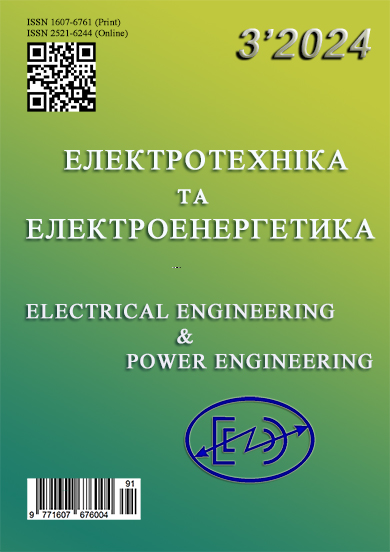Determination of voltage quality indicators in industrial power supply systems with limited energy system capacity
DOI:
https://doi.org/10.15588/1607-6761-2024-3-4Keywords:
voltage quality, higher harmonics, voltage asymmetry, voltage fluctuationsAbstract
Purpose. To justify the dependence of the determination of indicators of electromagnetic compatibility of power supply systems of industrial enterprises in the presence of powerful nonlinear and asymmetric loads in conditions of limited power system capacity.
Methodology. Methods of theoretical electrical engineering for the construction of replacement schemes of three-phase electrical networks, Fourier series for the analysis of higher harmonics of current and voltage, the method of symmetrical components for the analysis of asymmetry.
Findings. Виділено основні показники якості напруги, значення яких залежить від параметрів живлячої електроенергетичної системи (потужності короткого замикання). Наведено аналітичні залежності розрахунку показників несиметрії та несинусоїдальності при обмеженні потужності КЗ. Проаналізовано засоби корекції показників якості в умовах електричних мереж з розподіленою генерацією.
Originality. The scientific novelty consists in establishing the patterns of changes in the mode parameters of the industrial load from the parameters of the power system, which is expressed in interrelated changes in voltage quality indicators. At the same time, in the analytical models, the option of obtaining variable changes in the parameters of the power system both due to the generating capacities and through the parameters of the substitution schemes of electrical networks of different voltage classes has been added.
Practical value. For engineering calculations, simplified algorithms for determining voltage quality indicators (deviation, oscillation, asymmetry and non-sinusoidal voltage) are proposed, taking into account the real configuration of the electrical network and the actual power of the power system. This makes it possible to evaluate the efficiency of transmission and conversion of electricity under an arbitrary configuration of the post-emergency power supply scheme.
References
Papaika Y. Mathematical modeling of power supply reliability at low voltage quality / Yurii Papaika, Oleksandra Lysenko, Yevgenij Koshelenko, Illa Oli-shevskyi // Nauk. Visnyk Natsionalnoho Hirnychoho Universytetu, - 2021 (2), p.97–103. https://doi.org/10.33271/nvngu/2021-2/097.
Pivnyak G. Interharmonics in power supply systems / Gennadiy Pivnyak, Igor Zhezhelenko, Yurii Papaika, Oleksandra Lysenko // Naukovyi Visnyk Natsional-noho Hirnychoho Universytetu. - 2017 (6), pp. 109-114. ISSN 20712227.
Janik P. Influence of increasing numbers of RE-inverters on the power quality in the distribution grids: A PQ case study of a representative wind tur-bine and photovoltaic system / Przemyslaw Jan-ik, Grzegorz Kosobudzki, Harald Schwarz // Higher Education Press and Springer-Verlag. -2017. Berlin Heidelberg, https://doi.org/10.1007/s11708-017-0469-3.
Pivnyak G. ASSESSMENT OF POWER SUPPLY EN-ERGY EFFICIENCY BY VOLTAGE QUALITY CRITERION / Gennadiy Pivnyak, Oleksandr Azukovskiy, Yurii Papaika, Careres Cabana Edgar, Olczak Pawel, Artur Dyczko // Rynek Energii. - 2021 № 4(155). p. 75-84. ISSN 14255960.
IEEE 1547:2003-Standard for Interconecting Distrib-uted Resources with Electric Power System.
Standard IEC61000-2-4–2002. Electromagnetic com-patibility (EMC)–Part 2-4: environment-compatibility levels in industrial plants for low-frequency conducted disturbances.
CENELEC EN 50160–2010. Voltage characteristics of electricity supplied by public electricity networks.
Pivniak H. Problems of development of innovative power supply systems of Ukraine in the context of European integration / H. Pivniak, O. Aziukovskyi, Yu. Papaika, I. Lutsenko, N. Neuberger // Naukovyi Visnyk Natsionalnoho Hirnychoho Universytetu. - 2022 (5), 89-103. https://doi.org/10.33271/nvngu/2022-5/089.
Shcherba M. Mathematical Modeling of Electric Cur-rent Distribution in Water Trees Branches in XLPE Power Cables Insulation / M. Shcherba, A. Shcherba, Y. Peretyatko // Proc. IEEE 7th International Con-ference on Energy Smart Systems. ESS 2020. Kyiv, Ukraine, May 12-14, 2020. p. 353–356. https://doi.org/10.1109/ESS50319.2020.9160293.
DSTU EN 50160:2023 (2023). Haracterystyky naprugy elektropostaczannya v mererzach zagalnogo pryznaczennya, Kyiv, Minekonomrozvytku Ukrainy.
(Characteristics of power supply voltage in general-purpose electrical networks, Kyiv, Ministry of Eco-nomic Development of Ukraine), 27.
Sokol E.I. Nesynusoidalni ta nesymetriczni rerzymy v electroenergetycznych systemach (Non-sinusoidal and non-symmetric modes in electric power systems) / E.I Sokol, G.А. Senderovicz, О.G. Gryb and others. – Kharkiv: FOP Brovin О.V., 2021. -202 p.
Smolenski R. Conducted electromagnetic interfer-ence (EMI) in Smart Grids / R. Smolenski. London, Springer, 2017, 198 рр.
Babak S. Analysis of UAVs and Their Technical Parameters for Overhead Power Lines Monitoring / S. Babak, A. Zaporozhets, O. Gryb, I. Karpaliuk // Studies in Systems, Decision and Control. – 2023. 454, p. 181–193 https://doi.org/10.1007/978-3-031-22464-5_10.
Sokol Y. Theoretical Basis of Determination of Corona Discharge Coordinates by Acoustic Radiation / Y. Sokol, V. Babak, A. Zaporozhets, O. Gryb, I. Karpaliuk, R. Demianenko // Studies in Systems, Decision and Control, – 2024. 509, p. 137–153. https://doi.org/10.1007/978-3-031-44025-0_7.
El Hajji. The electromagnetic interferance caused by high voltage power lines along the electrical rail-way equipment / El Hajji, H. Mahmoudi and M. Labbadi // International Journal of Electrical and Computer Engineering, vol. 10, no. 5. - 2020, p. 4581-4891. https://doi.org/10.11591/ijece.v10i5.
Dusza D. Reactive power measurements based on its geometrical interpretation / D. Dusza, G. Kosobudzki // 2018 14th Selected Issues of Electrical Engineer-ing and Electronics, WZEE. - 2018, 8749118. https://doi.org/10.1109/WZEE.2018.8749118.
Downloads
Published
How to Cite
Issue
Section
License
Copyright (c) 2024 Yu.A. Papaika, O.G. Lysenko, M.M. Malyshko, O.V. Udovyk

This work is licensed under a Creative Commons Attribution-ShareAlike 4.0 International License.
Creative Commons Licensing Notifications in the Copyright Notices
Authors who publish with this journal agree to the following terms:
Authors retain copyright and grant the journal right of first publication with the work simultaneously licensed under aCreative Commons Attribution License that allows others to share the work with an acknowledgement of the work's authorship and initial publication in this journal.
Authors are able to enter into separate, additional contractual arrangements for the non-exclusive distribution of the journal's published version of the work (e.g., post it to an institutional repository or publish it in a book), with an acknowledgement of its initial publication in this journal.
Authors are permitted and encouraged to post their work online (e.g., in institutional repositories or on their website) prior to and during the submission process, as it can lead to productive exchanges, as well as earlier and greater citation of published work.

